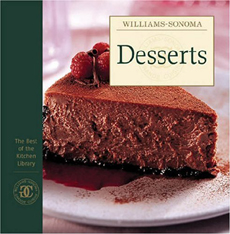 
There is a little bit of everything in this sweet cookbook.
|
| Jill Cornfield has been a passionate cook and baker since the age of 8, when she learned the difference between t and T in a recipe, and the snickerdoodles had to be thrown away.
|
|
July 2005
|
 |
Williams-Sonoma Desserts: The Best of the Kitchen Library
By Chuck Williams (Editor)
Even though I always think I’ve developed a little more self-control with a little more age, every dessert cookbook sends me reeling down the path to regression, and I feel like a 10-year-old again. “Oh, god,” I thought, as I was flipping through the Williams-Sonoma Desserts book, “I want to make everything.” Took a deep breath, decided to make something easy. Fortunately, most recipes are a snap to accomplish, and even novice cooks will gain a sense of competence.
“Desserts” has a straightforward appeal, from its sensible organization of chapters to its clean-cut brightly flavored recipes. Chapters include cookies, bars and confections; cakes, cupcakes and cheesecakes; pies and tarts; and fruit desserts, and end with basic recipes and techniques, a useful section for the beginning cook or anyone who would benefit from step-by-step photographs of making pie crust, granita, sherbet and ice cream. Basic recipes – among others, for sour cream fudge frosting and vanilla buttercream, both with a number of flavor variations – have brief, useful introductions.
What I think of as pointless food writing is blessedly absent. Instead, recipe introductions give sensible information on flavor, technique or history: “Angel food cake is cooled upside down, so you will need a tube pan with legs on the rim ...” “Midsummer, when nectarines are at their peak, is the best time to make this simple and elegant dessert.” “Grand Marnier, Cuacao, Cointreau or Triple Sec can be used for the orange-flavored liqueur here....” “The name for this popular custard translates as ‘burnt cream’ and the name fits.”
I was immediately attracted to a number of the ice creams. If you don’t like sour cream, you won’t like the tangy brown sugar and sour cream ice cream, which is a bit better after a day in the freezer, but I found it very good indeed. Others on my list are peppermint stick ice cream with chocolate fudge sauce and the chocolate mandarin ice cream.
Some of the bar cookies are quick enough for a school bake sale, and that’s just where the first batch of s’mores bars went. They proved simple enough to mix up after dinner one evening. After a night in the fridge they were firm enough to transport without incident, and they were a huge hit. I thought there wasn’t enough chocolate; someone else thought there weren’t enough marshmallows, but all bars got eaten. I made a batch for the neighbors and then finished off a dinner party with yet a third. Also worth trying are the several brownie variations: pecan brownies, hazelnut orange brownies, cappuccino-walnut brownies and congo squares, a non-chocolate brownie cousin.
Except for a very few examples, you won’t find any sweetened condensed or evaporated milk in this cookbook. Tapioca brulee with sun-dried blueberries calls for sweetened condensed milk and the s’mores bars use mini marshmallows but most recipes depend on ingredients you can find in any Whole Foods market. In fact, a farmer’s market would be a great place to shop for the recipes that demand first-rate produce, such as persimmon chiffon pie, hazelnut raspberry torte, baked fresh figs in port and cassis coeur a la creme, among others.
It’s hard to go wrong with butter, chocolate, sugar and cream, and no stinting, either. Interestingly, many of the ice cream recipes depend on a custard base of egg yolks and light cream (half and half). I found it mildly distracting that British usage is given in parentheses (plain flour, single cream, double cream, essence, 60 g). On the other hand, I often wish that British cookbooks would translate their weights into our measurements, so maybe this is just going to make some cooks across the pond very happy.
Chocolate lovers will appreciate the many ways in which chocolate can be loved: cocoa meringue kisses, Denver chocolate pudding cake, Mississippi mud cake, chocolate decadence, chocolate mousse, no-fail fudge and chocolate nut bark are just a handful.
The wide-ranging nature of “Desserts” makes it a useful basic desserts cookbook, with recipes that will attract experienced cooks and not disappoint less-experienced ones.
- 336 pages
- Oxmoor House
- 2005
—A favorite book of Jill Cornfield

|




